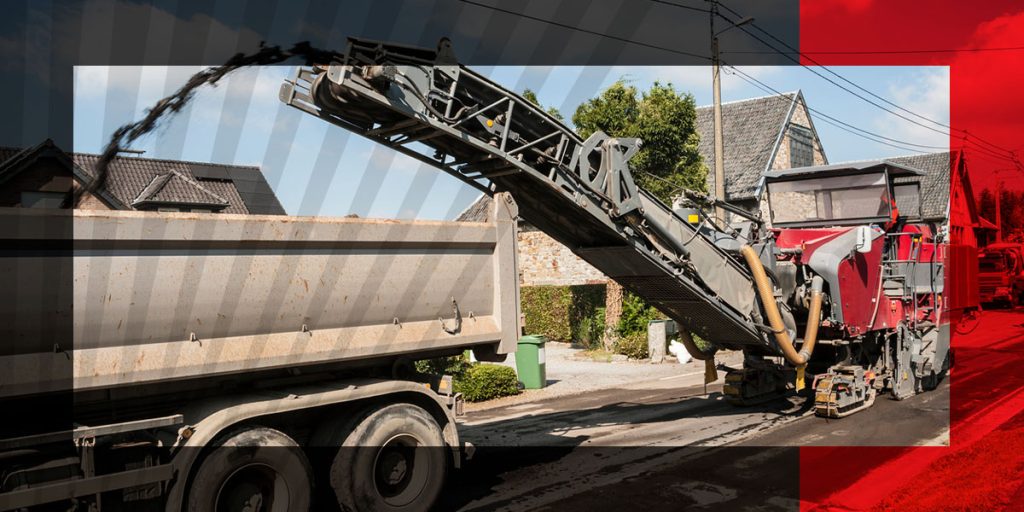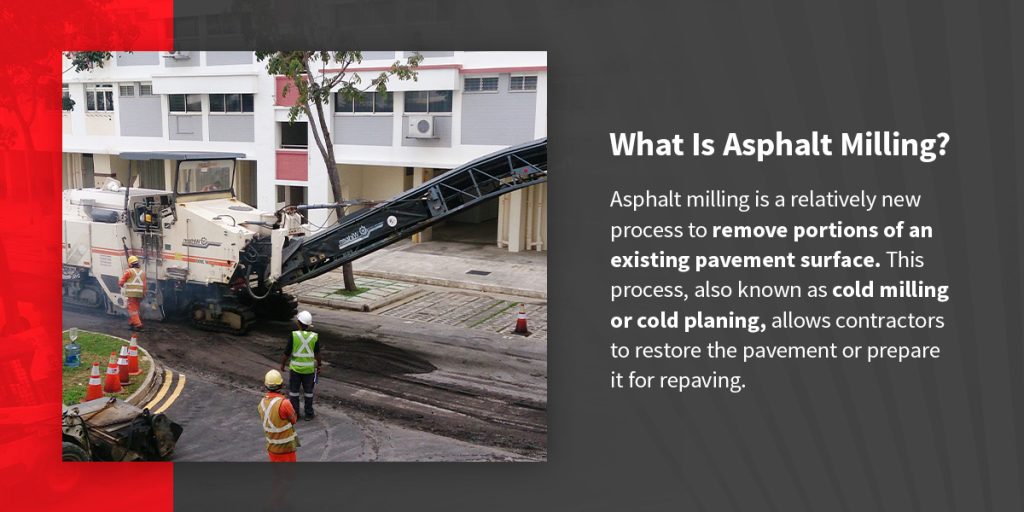
Whether you need to repave the surface of a roadway, prevent the pavement from getting too high or solve drainage problems in a parking lot, asphalt milling is an effective and reliable way to achieve your goals.
As a contractor, you can experience the many benefits of asphalt milling no matter what kind of project you are working on. Road milling leaves the underlying sub-base and existing structures untouched, so you only need to remove the top layer, saving both time and money. This process is also beneficial whenever you want to recycle the road surface.
Check out our ultimate guide to learn more about the road milling process.

What Is Asphalt Milling?
Asphalt milling is a relatively new process to remove portions of an existing pavement surface. This process, also known as cold milling or cold planing, allows contractors to restore the pavement or prepare it for repaving.
Depending on a business owner’s or municipality’s goals, the asphalt surface can be ground to different levels. Specially designed asphalt milling equipment makes it possible to reach depths ranging from just a few inches to a full-depth removal. To remove a few inches, a cold milling machine will go over the surface and remove the layer in just one pass. For a full-depth removal, the entire pavement surface is ripped apart and taken to a recycled asphalt pavement (RAP) processing facility.
Either way, this method creates a smooth, even surface free from irregularities that would negatively impact repaving. Also, instead of doing a complete demolition, asphalt milling allows contractors to achieve a similar result for less. Asphalt milling can restore all types of damaged pavement.
Asphalt milling offers an affordable and sustainable solution for many other irregular or damaged surfaces, including sidewalks, driveways and parking lots. The process also makes it possible to recycle the old asphalt pieces, referred to as milling, so they can be used for resurfacing the pavement or in future projects.
How Is Asphalt Milling Done?
Suppose there is significant damage to the pavement surface, whether from an uneven slope to widespread cracking. In that case, pavement milling can remove the damaged layers and restore the appearance and functionality of the surface.
The process involves various equipment, including road milling machines, sweepers, dump trucks and water trucks. Together, this equipment will cut, compact and redistribute the asphalt pieces.
Here is the basic process involved in milling a road.
1. The Asphalt Milling Machine Cuts the Pavement
To begin the process, a milling machine digs up and grinds the asphalt surface. These machines have rows of metal cutting teeth on a cutting drum that rotates across the pavement’s surface. These teeth remove a few inches from the asphalt.
Depending on how much of the existing surface you need to remove, you can adjust the machine to reach the right depth.
2. Road Millings Are Removed and Placed in a Dump Truck
Once the asphalt goes through the grinder and gets crushed, the machine screens the pieces. A vacuum cleans up the asphalt millings, transferring them to a conveyor system at the front of the milling machine.
This system moves the milling to the dump truck so it can be transferred to a RAP facility and reused.
3. Sweeper Cleans up Asphalt Millings
Breaking up the existing asphalt creates a lot of dust and debris. Before the new asphalt can be laid, the surface must be thoroughly swept.
A sweeper cleans up any remaining asphalt millings to make a smooth surface for paving.
4. Fresh Asphalt Is Laid
Once the surface is free from all dust and debris, the new asphalt can be laid. With the proper preparation, it should easily bond to the new surface.
Asphalt Millings vs. Gravel
While gravel can be suitable for some projects, there are many advantages of using construction milling instead. Here are some of the advantages of using millings:
- Cost-effective solution: Because the road millings are recycled from the pavement, you will already have the material needed for your next project. There is also no additional cost to haul gravel to the site. Reusing the old asphalt pavement pieces cuts down on the overall project cost.
- Easier to maintain: Along with helping cut costs, asphalt millings reduce the time spent maintaining the surface. The compact millings bind together once they are laid and harden to form a strong surface. Also, once it hardens, you will not have to reseal or refinish it. It may need to be recompacted occasionally, which is less costly and involved compared to repairing cracks.
- Resistance to harsh weather: Even in harsh climates that get a lot of rain or snow, you can count on asphalt millings to stand up to the elements. This material drains more quickly, making it adaptable to all weather conditions. Because it also produces less mud, there will be less cleanup time involved whenever it rains or snow and ice start to melt.
- Visual appeal: Asphalt millings also offer an aesthetically pleasing solution. It can be used in many projects, easily replacing traditional gravel or hot asphalt. It provides a simple look that blends well with the surrounding structures and buildings.
Benefits of Asphalt Milling
Asphalt milling can be used to repair surface flaws like cracking. Cracks can compromise the integrity of the surface, causing anything from water to road debris to enter through the cracks. The roadway milling process can also solve issues like raveling, which happens when the surface starts to disintegrate.
Asphalt milling also offers specific benefits, including:
- Less traffic disruption: Compared to other methods, this is a fairly quick process. It does not take long to repave the asphalt, and the equipment does not take up too much space. Even while paving, traffic can be moved, causing less disruption.
- Reduces skidding: If there is an uneven surface with bumps or ruts, asphalt milling can restore the pavement. This reduces dangerous situations like skidding, which could affect both the surface and the safety of drivers.
- Environmentally friendly: One of the most notable benefits of asphalt milling is how environmentally friendly the process is. Whenever asphalt is milled, it produces reclaimed asphalt pavement. This new material can be recycled with either hot or cold recycling. It can be reused in current or future pavement projects, ranging from new parking lots to restored shoulders of roads, which saves landfill space.

Use Stewart-Amos Sweeper Co. in Your Asphalt Milling Process
At Stewart-Amos Sweeper Co., you will find the street sweepers you need to complete your asphalt milling process easily. No matter your surface and cleaning needs, we have an extensive line of mechanical brooms that will deliver reliable results.
Contact us today to find the right sweeper truck for your asphalt project.
